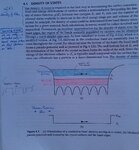Follow along with the video below to see how to install our site as a web app on your home screen.
Note: This feature may not be available in some browsers.


INS-ANI said:who said so?
which charge carrier depends on kind of doping.
If its N-type doping, there are more electrons wrt. holes(or absence of electrons) in the semiconductor.
In other case if its a P-type doping, then there are more holes wrt. electrons in the semiconductor.
So,the mobility depends on type of doping on the semicnductor.





There is a Quantum explanation:
E(k) -->spectrum of Hamiltonian
E in a eigenvalue of Hamiltonian-Shrödinger equation.
k is related with p and kinetic energy.
In crystal, atom, the description of electron motion is made by Quantum Mechanics.
Band diagram where we have parabolic regime of E(K) like in free electron regime (not real, neither quantic).
The efective mass of particle that carries current in valence band is related with E(K) of valence band.
The wavefunction carries momentum, we know that 2nd Law of Newton F=dp/dt=m*a
Knowing p we can calculate dp/dt, and a=dv/dt v=wave group velocity
and so on...
**broken link removed**


i read sth about how to achieve effective mass in infinte potential well problem, i don't get the second part of your word! tunneling efect which describe the reverse current in p-n junction!Conduction in cunduction band is governed by the sommerfeld assumption. An electron in an infinite potential well. The well is defined by the material size. The well limits are the limits of the material as a whole. Inside of it the electron is not affected by the micropotential of the particular lattice atoms. It is almost like free electron inside the material. On the other hand, "conduction" in the valence band is in fact electrons moving from bond to bond. Quantomechanically this can only be described by the tunneling effect! In order for an electron to move to a nearby covallent bond, it has to brake the potential between atoms through tunneling effect. Like drilling a hole in the wall to pass a tennis ball to the next appartment. Conduction through tunnelling effect requires more effort than the semi-free mechanism of of sommerfeld conduction. This is depicted as different effective masses for semi-free electron conduction to tunneling effect conduction mechanism.


No. when a valence electron is moving from atom to atom it finds a barrier potential which has to pass through. The only way a valence electron can move from atom to atom is via tunnel effect. As far as i know at least. I was not reffering to p-n junction.
--- potential--------potential
------well--------------well
--- of atom1-------of atom2
|---------------|\|------------|
|------ e->---|\\|------------|
|-------------|\\\|------------|
|------------|\\\\|------------|
|------------|\\\\\|-----------|
|-----------|\\\\\\\|-----------|
|(atom1)-|\barrier\|-(atom2)---|
|----------|\potential\|---------|
 image from Pierret-advanced semiconductor foundamentals
image from Pierret-advanced semiconductor foundamentals


Well... i was expecting the valence band to be lower in comparison to the diagram you have uploaded.. In that case the tunneling effect would make sense for explaining conductivity. I was imagining the Kroenig-Penny periodic-potential model to be inside the valenve band. Where did you get this scanning from? The book title i mean.


Maybe the real problem is due to the desperate effortLook at it this way. A freed electron just goes where it's
pushed / pulled by the field, with fairly sparse interaction.
A hole, however, is really the -absence- of an electron
and for that "bubble" to move, electron after electron
has to "get out of its way". That's always going to be a
slower process.


Maybe the real problem is due to the desperate effort
to "intuitively" understand results (such as mobility or effective mass)
that have been deduced by absolutely "non intuitive" quantum/mechanics postulates.

People deduced, or intuited, those postulates at one point.
Now people think they're the only valid way to understand
what goes on. Especially ones with too much book time and
not enough grit under their fingernails.
If you're feeling all proud about your mathematics, good for
you. But sometimes a simple answer has all the truth a
simple question needs. And I doubt your postulate of choice
has any better explanatory power. Though it's likelier to
please a professor.